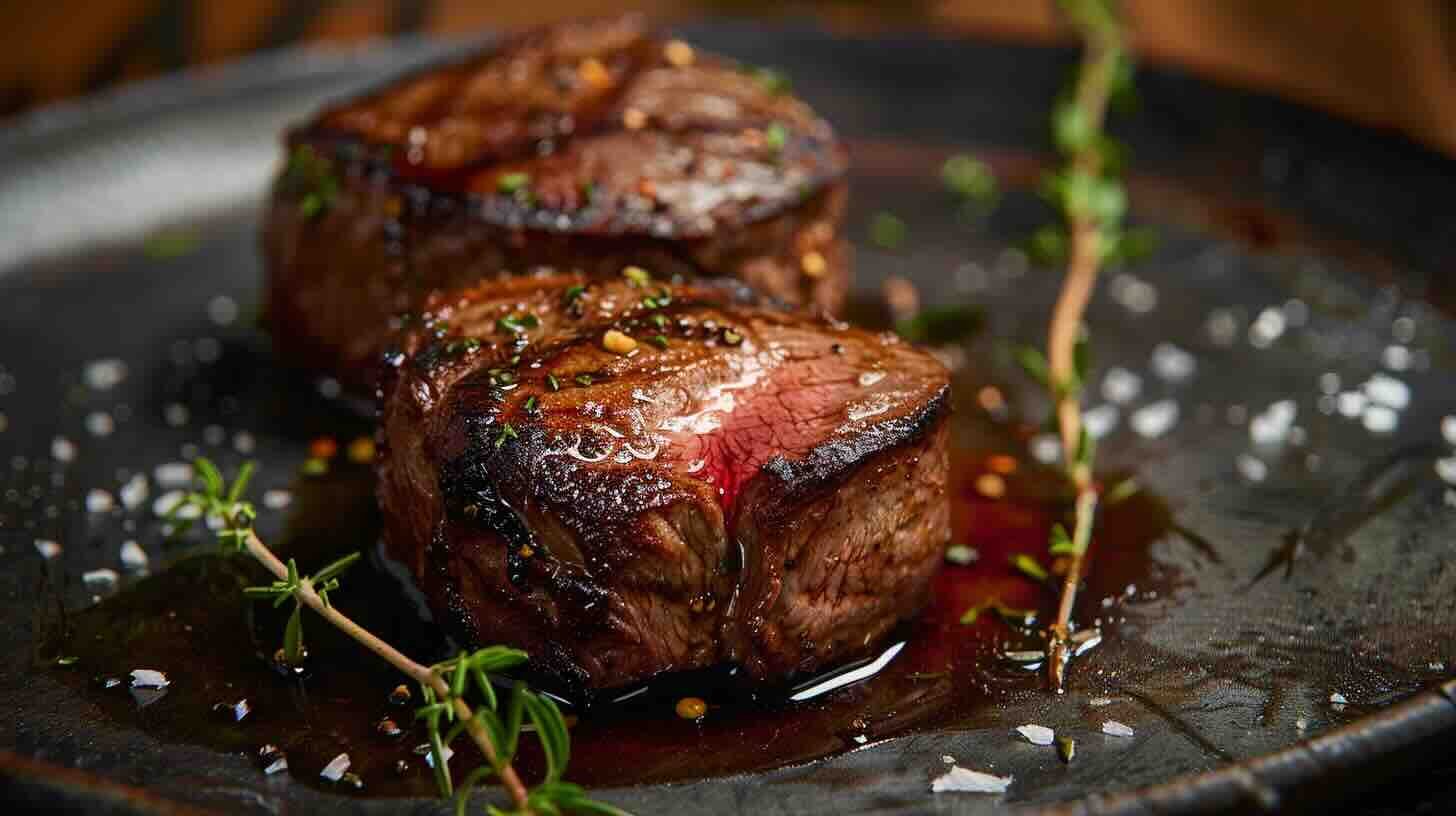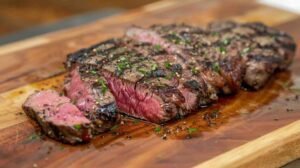Introducing Reverse Sear Steak
Understanding the Reverse Sear Method
The reverse sear method flips the traditional steak-cooking process on its head. Instead of searing the steak first and then finishing it in the oven, you start by slowly cooking the steak at a low temperature in the oven. Once the steak reaches the desired internal temperature, it’s finished off by searing in a screaming-hot pan to form that irresistible browned crust (Wholesome Yum). This technique is popular among chefs and foodies for its ability to deliver consistently perfect results similar to sous vide cooking but using an oven instead.
The steps to achieve a perfectly cooked reverse sear filet mignon are straightforward:
- Preheat your oven to a low temperature (usually around 250°F).
- Season the steak generously.
- Place the steak on a wire rack set over a baking sheet.
- Cook in the oven until the steak reaches your desired internal temperature.
- Heat a cast-iron skillet until it’s extremely hot.
- Sear the steak for a minute or two on each side until a crust forms.
For a detailed guide, check out our how to reverse sear steak article.
Benefits of Reverse Searing
The reverse sear method offers several benefits that make it a favorite among steak enthusiasts:
- Even Cooking: The low, slow cooking process ensures that the steak is cooked evenly from edge to edge. This means no more overcooked edges and undercooked centers.
- Enhanced Flavor: The final sear in a hot pan creates a delicious, caramelized crust, enhancing the steak’s flavor.
- Juiciness: Slow cooking at a low temperature helps retain the steak’s natural juices, resulting in a moist and tender filet mignon.
- Consistency: This method provides a reliable way to achieve the perfect steak every time, making it a go-to technique for both home cooks and professional chefs.
For more insights on why this method is so effective, visit our page on reverse sear steak recipe.
| Benefit | Description |
|---|---|
| Even Cooking | Ensures the steak is uniformly cooked from edge to edge. |
| Enhanced Flavor | Creates a caramelized crust that boosts the steak’s flavor. |
| Juiciness | Retains the steak’s natural juices for a moist and tender result. |
| Consistency | Provides reliable results, making it a preferred method among chefs. |
For those who love experimenting with different steak cuts, the reverse sear technique can also be applied to other varieties such as reverse sear tomahawk steak and reverse sear ribeye steak.
Choosing the Right Cut
Selecting the appropriate cut of steak is essential for mastering the reverse sear technique. For this method, filet mignon stands out as the optimal choice due to its unique characteristics.
Why Filet Mignon Works Best
Filet mignon is renowned for its tenderness and mild flavor. This cut is taken from the smaller end of the tenderloin, making it one of the most tender cuts you can find. Because of its leanness and delicate texture, filet mignon benefits greatly from the reverse sear method. This technique ensures a juicy, tender interior and an intensely flavorful, golden-brown, crispy exterior (Kansas City Steaks).
The reverse sear process involves cooking the steak at a low, steady temperature in the oven, followed by a quick sear in a hot skillet. This method results in a beautifully cooked interior while achieving a perfectly seared exterior, enhancing the overall flavor and texture of the steak (Kansas City Steaks). The mild flavor of filet mignon allows it to absorb the rich, caramelized flavors developed during the searing process, making it a standout choice for this cooking method.
Steak Thickness and Quality
The thickness and quality of your steak are critical factors in achieving the best results with the reverse sear technique. For optimal outcomes, the steak should be at least 2 inches thick. Thicker cuts like filet mignon, Cowboy-Cut Ribeye Steaks, and Tomahawk Steaks are ideal candidates for reverse searing (Kansas City Steaks).
| Steak Cut | Recommended Thickness |
|---|---|
| Filet Mignon | 2 inches |
| Cowboy-Cut Ribeye | 2 inches |
| Tomahawk Steak | 2 inches |
When it comes to quality, opting for a well-marbled steak with a good amount of intramuscular fat will enhance the flavor and juiciness of the meat. High-quality, well-marbled steaks hold up better to the reverse sear method, ensuring a tender and flavorful result.
For the best results, use a meat thermometer to monitor the internal temperature of the steak throughout the cooking process. This ensures that the steak is cooked to your desired level of doneness. Refer to the Measuring Doneness Chart for precise internal temperatures for various levels of doneness. For more tips on perfecting the process, visit our guide on how to reverse sear steak.
By understanding why filet mignon works best and considering the thickness and quality of your steak, you can master the reverse sear technique and create a delicious, perfectly cooked steak every time. For more variations and suggestions, check out our sections on reverse sear tomahawk steak and reverse sear ribeye steak.
Mastering the Reverse Sear Technique
Reverse searing is a method that flips the traditional steak-cooking process on its head. Instead of searing the steak first and then finishing it in the oven, the reverse sear method involves slowly cooking the steak at a low temperature in the oven and then searing it in a hot pan to create that irresistible crust (Wholesome Yum). This technique ensures a perfectly cooked interior and a beautifully browned exterior.
Step-by-Step Guide to Reverse Searing
- Preheat the Oven: Set your oven to 250°F (121°C). This low temperature ensures the steak cooks evenly.
- Season the Steak: Generously season your filet mignon with salt and pepper. Let it sit at room temperature for about 30 minutes.
- Cook in the Oven: Place the steak on a wire rack set inside a baking sheet. Insert a meat thermometer into the thickest part of the steak. Cook in the oven until the internal temperature reaches 10-15°F below your desired final temperature. Use the table below for reference:
Desired Doneness Pull from Oven Temp Final Temperature Rare 115°F (46°C) 125°F (52°C) Medium Rare 125°F (52°C) 135°F (57°C) Medium 135°F (57°C) 145°F (63°C) Medium Well 145°F (63°C) 155°F (68°C) - Heat the Pan: While the steak is in the oven, heat a cast-iron skillet over high heat until it’s screaming hot.
- Sear the Steak: Add a tablespoon of oil with a high smoke point (like canola oil) to the pan. Sear the steak for 1-2 minutes on each side until a deep brown crust forms.
- Rest the Steak: Remove the steak from the pan and let it rest for at least 5 minutes before slicing. This allows the juices to redistribute throughout the meat.
For more detailed instructions, check out our guide on how to reverse sear steak.
Tips for Perfecting the Process
- Use a Meat Thermometer: A probe thermometer is essential for monitoring the internal temperature of your steak accurately. This ensures that you don’t overcook or undercook your meat.
- Resting Time is Crucial: Allow the steak to rest after searing. This step is vital for juicy, tender meat.
- High-Quality Pan: Use a cast-iron skillet for the sear. Its ability to retain and distribute heat evenly helps achieve that perfect charred crust.
- Choose Thick Cuts: Filet mignon is ideal for reverse searing due to its thickness. Thicker steaks allow for a more even cook and better control over the final temperature.
- Plan Ahead: The reverse sear process takes time, so plan your meal accordingly. If you’re in a rush, you might prefer quicker methods like those used for sirloin or flank steak (Wholesome Yum).
For other variations and techniques, don’t forget to explore our recipes for reverse sear tomahawk steak and reverse sear ribeye steak.
Variations and Serving Suggestions
Grilling vs. Oven Method
When it comes to reverse searing filet mignon, both grilling and oven methods can be employed to achieve that perfect steak. Each method has its unique advantages and can be chosen based on personal preference or available equipment.
Grilling Method
- Preheat the Grill: Start by preheating your grill to a low temperature, around 250°F.
- Indirect Heat: Place the filet mignon on the grill using indirect heat. Close the lid and cook until the internal temperature reaches about 10°F below your desired doneness.
- Searing: Once the steak reaches the target temperature, move it to the hottest part of the grill for a quick sear, about 1-2 minutes per side, to achieve a charred crust.
Oven Method
- Preheat the Oven: Preheat your oven to 275°F.
- Cooking in the Oven: Place the filet mignon on a wire rack over a baking sheet. Cook in the oven until the internal temperature is 10°F below your desired doneness.
- Searing in a Skillet: Transfer the steak to a preheated cast-iron skillet and sear over high heat for 1-2 minutes per side to develop a flavorful crust.
| Method | Initial Temperature | Cooking Time | Searing Time |
|---|---|---|---|
| Grilling | 250°F | Varies by thickness | 1-2 minutes per side |
| Oven | 275°F | Varies by thickness | 1-2 minutes per side |
For more on how to reverse sear steak, visit our detailed reverse sear steak recipe.
Pairing with Sides and Sauces
Pairing the perfect sides and sauces can elevate your reverse-seared filet mignon to a gourmet meal. Here are some suggestions:
Sides
- Garlic Mashed Potatoes: Creamy and flavorful, they complement the richness of the steak.
- Roasted Asparagus: Adds a touch of freshness and crunch.
- Sautéed Mushrooms: Enhance the umami flavor of the steak.
- Grilled Vegetables: A healthy and colorful addition to your plate.
Sauces
- Red Wine Reduction: A classic choice that adds depth and richness.
- Bearnaise Sauce: Luxuriously creamy with a hint of tarragon.
- Garlic Butter: Simple yet flavorful, perfect for drizzling over the steak.
- Peppercorn Sauce: Adds a bit of spice and complexity.
For more ideas on sides and sauces, explore our reverse sear ribeye steak article to find complementary pairings.
By experimenting with different cooking methods and pairing options, you can customize your reverse sear filet mignon to suit any occasion. Whether you prefer the smoky flavor of the grill or the controlled environment of the oven, the reverse sear technique ensures a perfectly cooked steak every time. For more inspiration, check out our guide on reverse sear tomahawk steak.



